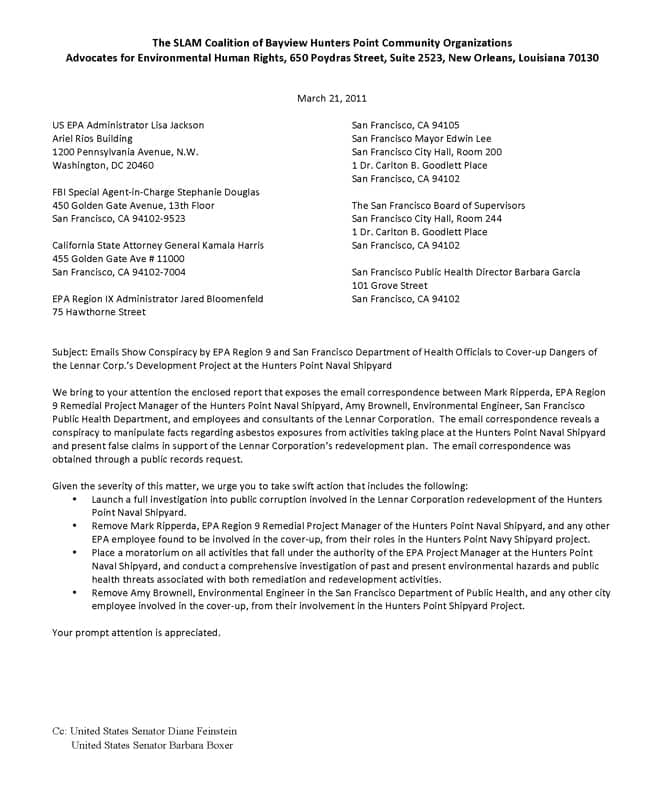Pack the courtroom on Thursday, March 24, 9:30 a.m., at Superior Court, 400 McAllister St., Room 613, San Francisco, for a hearing on Lennar’s EIR – scroll down for more info and a report on the hearing
by Jaron Browne

However, little did residents know that officials in the Environmental Protection Agency Region 9 and the San Francisco Department of Public Health were conspiring with Lennar to conceal the health threats of asbestos laden dust.
Email correspondence obtained through a public records request now reveals that Mark Ripperda, EPA Region 9 remedial project manager for the Hunters Point Naval Shipyard, and Amy Brownell, environmental engineer at the San Francisco Department of Public Health, used their offices to manipulate environmental data and create false reports in support of Lennar’s plan for a major redevelopment project on the shipyard site.
Their numerous emails to employees and consultants of the Lennar Corp. show a concerted effort to conceal asbestos exposures in order to avoid the shutdown of redevelopment activities. Additional email correspondence indicates a conspiracy to create a justification for Lennar’s redevelopment project to move forward. Excerpts from their emails follow.
EPA email excerpts: Asbestos exposure coverup
1) May 14, 2009, 3:37 p.m.
From: Mark Ripperda, EPA Region 9
To: Jeff Austin, Lennar Corp. employee

*Note: The Nation of Islam operates a school for children ages 3 to 18 that is located next to the Hunters Point Naval Shipyard in the Bayview Hunters Point community.
2) June 24, 2009, 10:00 a.m.
From: Mark Ripperda, EPA Region 9
To: Rob Balas, principal of Iris Environmental, Inc., consultant to the Lennar Corp.
Re: Asbestos data flow chart call – 6/22
“We would like to take Lennar up on their offer to analyze the additional 8 samples from Lennar monitors so that we can do 16 filters from the City. This will also help lower the ‘worst case risk’ by including more samples with lower counts.”
3) Oct. 28, 2009, 1:26 p.m.

To: Rob Balas, principal of Iris Environmental, Inc., consultant to the Lennar Corp.
Re: Hunters Point data re-analysis
“We’re meeting with the BAAQMD [Bay Area Air Quality Municipal District] and the City on November 3, and would like to meet with you soon thereafter to discuss the details and talking points. I prefer to keep our message as simple as possible and stay away from health assessments and from shutdown days. Something along the lines of: Our analysis using more detailed methodology showed that there are fewer ‘health risks fibers’* present than what the Air District assumed in setting the trigger levels.* Thus the Air District’s methods and levels are appropriate and we will defer all regulatory issues concerning asbestos to the District.
“I’m not the asbestos expert, so is this a true statement?”
*Note: “Health risk fibers” refer to a concentration of asbestos that can cause adverse health effects. “Trigger levels” refer to the standards set by the Bay Area Air Quality Municipal District that require the shutdown of redevelopment activities by the Lennar Corp. at the Hunters Point Naval Shipyard when an air monitor detects 16,000 or more asbestos fibers in a cubic meter.
4) May 29, 2009, 4:16 p.m.
From: Rob Balas, principal of Iris Environmental, Inc., consultant to the Lennar Corp.
To: Mark Ripperda, EPA Region 9
Subject: Re: Hunters Point – Follow-up to Tuesday’s conference call

*Notes: AHERA stands for Asbestos Hazard Emergency Response Act and refers to one method of counting asbestos fibers in a given sample of dust.
Bayview Hunters Point residents repeatedly called on the EPA and the Health Department to conduct activity-based sampling, which is more statistically representative of actual human exposure to asbestos fibers. The EPA and the Health Department never complied with this request.
San Francisco Department of Public Health email excerpts: Asbestos exposure coverup
1) Jan. 19, 2007, 8:26 a.m.
From: David Rizzolo, San Francisco Department of Public Health

Cc: Rajiv Batia, San Francisco Department of Public Health
Subject: Re: Fwd: worst case exposure assumption
“there may be other problems with reanalyzing worker exposure samples by TEM.* you would have to get the okay from Gordon Ball. the big problem i see is that measurements that were low by PCM* often turn out to be very high when reanalyzed by TEM. this is not a problem with OSHA because OSHA does not recognize TEM measurements. however, explaining to workers what this new information means for them can be a problem (pandora’s box). that may be a bigger problem in reality than the one were are trying to address.

*Note: TEM stands for “transmission electron microscopy” and PCM stands for “phase contrast microscopy.” Both are methods used in microscopes to count the asbestos fibers.
2) Oct. 13, 2006, 3:52 p.m.
From: Amy Brownell, San Francisco Department of Public Health
To: Sheila Roebuck and Jeff Austin, Lennar Corp. employees
Subject: very, very rough draft
“I’m sure you will also want to change my wording on how I portray the problems, lack of monitors, etc. Go ahead and change any way you want. I may change some of it back but I’m willing to read your versions. as noted, don’t bother adding the worker monitoring information. I don’t want to use it. I understand your sensitivity on this issue and if specifically asked in a public meeting, I will be willing to verbally state the facts related to worker monitoring. But I’m not willing to make it part of this narrative.”
EPA email excerpt: Concocting reasons for the Lennar redevelopment plan to move forward
1) Nov. 3, 2009, 12:10 PM
From: Mark Ripperda, EPA Region 9
To: Rob Balas, principal of Iris Environmental, Inc., consultant to the Lennar Corp., and Amy Brownell

“Hi Rob, here are the main talking points that we will be presenting at this afternoon’s meeting. You’ve been a careful reviewer of my language in the past – do you see any problems in how I’ve worded any of these points?”
2) Nov. 4, 2009 9:25 a.m.
From: Mark Ripperda, EPA Region 9
To: Rob Balas, principal of Iris Environmental, Inc., consultant to the Lennar Corp.
RE: HP [Hunters Point] asbestos re-analysis conclusions (2).doc.
“Thanks Rob, I appreciate your input and yes, you can share this internally with Lennar. These were talking points for yesterday’s meeting with the City and the Air District. … I need a different focus for meeting with both the NOI [Nation of Islam, administrator of the school located next to Hunters Point Shipyard] and the greater community. The conclusions for general communication will probably stay similar, with one addition, a statement that EPA sees no reason to stop the development.*

“While I’m not going to use the list you edited again, partially because of confusion it created for even informed people like you and Rajiv,* I’ll try and clarify a few things so we’re on the same page as we massage the message. … My statement in the conclusion is ambiguous, because I presented a risk for single worst case earlier in my list, but am then assuming that an average of the data will result in a much lower risk, without actually calculating a risk. I can’t use that logic for general communication for several reasons, one of which is because Christopher* will quickly point out that the highest level that we re-analyzed is not the highest level overall.”
*Notes: Following this email, Mark Ripperda, EPA Region 9 remedial project manager, repeatedly stated in public forums and meetings with local officials that EPA sees no reason to stop the Lennar Corp.’s redevelopment project at the Hunters Point Naval Shipyard. Ripperda’s statement served as justification for the San Francisco Planning Department to draft an environmental impact report in support of the redevelopment plan by the Lennar Corp. and for a majority of the San Francisco Board of Supervisors to approve the environmental impact report.
The people referenced in this email are Rajiv Bhatia, the director of occupational & environmental health in the San Francisco Department of Public Health, and Minister Christopher Muhammad, a community leader advocating for health protections from Lennar’s redevelopment activities at the Hunters Point Naval Shipyard.
The cozy relationship between regulators and industry
Governmental statements that have downplayed the dangers of recent environmental disasters, such as the BP oil drilling disaster in the Gulf of Mexico and the exposures to radiation from nuclear reactors damaged by the recent earthquakes and tsunami in Japan, have raised significant public distrust. Such distrust centers on the relationship that governmental regulators have with regulated industries.

Bayview Hunters Point is located in southeastern San Francisco. Residents of the community and surrounding neighborhoods are predominantly people of color, who are disproportionately burdened with environmental hazards from the Hunters Point Naval Shipyard Superfund Site, the city’s main sewage treatment plant, industrial facilities, diesel rail and truck corridors and substandard housing.

However, EPA and San Francisco Public Health Department officials have suppressed information about the full impact of these and other environmental hazards. Their unconscionable decision to manipulate data and present false reports constitutes a blatant disregard for the human rights of people who live, work and attend school in the Bayview Hunters Point community.
Demand for justice
Based on the obtained email correspondence, a coalition of residents and environmental justice and worker rights organizations are calling on FBI Special Agent-in-Charge Stephanie Douglas and California Attorney General Kamala Harris to:
- Launch a full investigation into public corruption involved in the Lennar Corp. redevelopment of the Hunters Point Naval Shipyard.

- Remove Mark Ripperda, EPA Region 9 remedial project manager for the Hunters Point Naval Shipyard and any other EPA employee found to be involved in the coverup from their roles in the Hunters Point Navy Shipyard project.
- Place a moratorium on all activities that fall under the authority of the EPA project manager at the Hunters Point Naval Shipyard and conduct a comprehensive investigation of past and present environmental hazards and public health threats associated with both remediation and redevelopment activities.
The coalition calls on San Francisco Mayor Edwin Lee, the San Francisco Board of Supervisors and San Francisco Public Health Director Barbara Garcia to:
- Remove Amy Brownell, environmental engineer in the San Francisco Department of Public Health, and any other city employee involved in the coverup from their involvement in the Hunters Point Shipyard Project.
- Launch a full investigation into public corruption involved in Lennar redevelopment of the Hunters Point Naval Shipyard.
The email correspondence obtained through a public records request is available at www.cleanupnotcoverup.com.
Jaron Browne, lead organizer for POWER (People Organized to Win Employment Rights), can be reached at jb@unite-to-fight.org or (415) 864-8372. This report is written on behalf of the SLAM Coalition of Bayview Hunters Point Community Organizations, of which POWER is a member, and Advocates for Environmental Human Rights, 650 Poydras St., Suite 2523, New Orleans, Louisiana 70130.
Hearing on legal challenge to Hunters Point redevelopment EIR Thursday, March 24
by POWER and Greenaction
The decades-long fight by the low-income residents of color in Bayview Hunters Point for environmental justice will clear an important hurdle Thursday as Judge Ernest Goldsmith hears arguments that the City of San Francisco and Lennar failed to disclose the potential health impacts of development on the toxic Hunters Point Naval Shipyard Superfund site.

The City and Lennar contend that they do not have to conduct such an analysis because the Navy is responsible for cleaning up the shipyard.
Yet as POWER and Greenaction have argued in a recent brief filed by attorneys from Earthjustice, “The purpose of preparing an EIR is not simply to generate paper but to fully understand and provide the public with a meaningful analysis of the environmental impacts of a project and mitigation measures to minimize such impacts.”
Specifically, the California Environmental Quality Act (CEQA) requires that if the developer is asking for approval to build on a toxic site, it must explain in accurate detail to what degree the land is contaminated and how they will protect the health of the existing population, the workers at the construction site, remediation workers and the new population coming into the area.
“Look, it’s simple. We just want development that is safe for the workers, the community and anyone working, living and raising families in our neighborhood,” said Bayview resident Esselene Stancil. “Any community deserves that. We want the same careful consideration that other communities get.”
Health concerns with development at the Superfund site are also heightened by the Navy’s proposal for an “early transfer” of the Shipyard parcels which would allow the Navy to transfer the land to the City before it is fully clean, making the City and Lennar responsible for the remaining remediation at the site.
“Right now the whole world is watching Japan in shock at how we could have allowed such a precarious situation to exist in the first place,” said Marie Harrison, a longtime Bayview activist with environmental justice group Greenaction. “Here in San Francisco today we have the opportunity to avoid the disastrous conditions that develop when we allow corporations to cut corners. We can and we must do better and comply with the law.”

“It may be inconvenient, but it is in fact the truth that the Hunters Point Shipyard is extremely contaminated land,” said Jaron Browne of POWER. “Superfund is the classification for the most toxic sites in the country. It’s shocking that the City and Lennar chose not to address the biggest question everyone needs to understand before we can make an informed decision about whether or not the site can be safely developed for housing and other public access.”
Judge Goldsmith will likely issue a ruling sometime in the coming months. If the judge rules in favor of the complaint raised by POWER and Greenaction, the City and Lennar will have to disclose the health impacts of the contamination and the mitigation plans related to the cleanup. They would then release a new draft environmental impact report for the shipyard that includes this critical information.
Hunters Point community organizations have also released a report (republished above) showing emails over the past five years between EPA, the San Francisco Department of Public Health and Lennar that reveal a conspiracy to manipulate facts regarding asbestos exposure from construction activities taking place at the shipyard and to present false claims in support of Lennar’s redevelopment plan. The emails were obtained through a Freedom of Information Act request.
The Hunters Point Shipyard served as a working naval operation from 1941 to 1974. The site included the Naval Radiological Defense Laboratory, which was involved in the decontamination of ships exposed to atomic weapons testing and conducted experiments on radiological decontamination and the effects of radiation on living organisms and materials. The shipyard was later leased to the Triple A Machine Shop, a company that was eventually charged with criminal violations for the illegal storage and disposal of hazardous waste on the property. In 1989, the shipyard was designated as San Francisco’s only federal Superfund site under the Comprehensive Environmental Response, Compensation, and Liability Act (CERCLA).
An independent analysis of the Shipyard site has shown the presence of extremely toxic contamination including radionuclides, VOCs (such as benzene, carbon tetrachloride, chloroform, naphthalene, tetrachloroethane and others), semi-volatile organic compounds, petroleum hydrocarbons, polycyclic aromatic hydrocarbons, PCBs, pesticides, heavy metals (arsenic, beryllium, chromium, chromium VI, lead, manganese, mercury and nickel) and asbestos.
Asthma, breast cancer and other respiratory illnesses are among the health impacts reported by Bayview residents living close to the Superfund site.
Update: Report on March 24 hearing
Thank you so much to everyone who came and out and packed the courtroom! Your presence made a huge impact. We wanted to send you all a quick update about what happened at our hearing at Superior Court.
The hearing went all day, from 10 a.m. to 4 p.m. The judge seemed to respond very favorably to the issues that POWER and Greenaction raised, particularly:
1. Our core concern about the failure of the EIR to adequately address the toxic contamination at the shipyard.
2. Our argument that the EIR’s description of the project is extremely confusing and fails to tell us exactly what the project is. Lennar and the City did something very unusual with this EIR by including several “variants” as part of project description. For example, in one scenario, the project might feature a new 49ers stadium. If not, it could be a research and development building. In another scenario, it could be some combination of housing and research facilities.
Those are very different projects and all have very different impacts. It is completely unprecedented under CEQA to propose an array of different projects. The project has to be described as one clear plan. Otherwise confusion arises for the decision makers and the public who need to be able to assess the actual environmental impacts accurately. That was a really big deal to the judge.
3. The judge was also suggesting that the scope of this project is so big – 770 acres – and lasts so many years – 20-30 years of construction – that he thought that was part of the problem for Lennar and the City. He was encouraging Lennar and the City to break the project up into manageable pieces and bring in separate EIRs over time. This would enable them to more effectively explain and account for exactly what they are planning to build and what the various environmental impacts of the project are.
The judge has not ruled yet. In the hearing he just raised the questions that he was grappling with, about where Lennar and the City’s EIR did not seem to be in compliance with CEQA.
Toward the end of the hearing, Lennar and the City requested a meeting with POWER, Greenaction and our lawyers. We agreed to meet with them.
The judge continued our hearing until April 18 to allow time for this meeting. All arguments have been presented. The hearing on April 18 will be to report back to the judge if anything comes from the meeting between the parties.
After the hearing on April 18, we expect that the judge would issue a ruling sometime in the coming months.
Visit POWER (People Organized to Win Employment Rights) and Greenaction to learn more and get involved.

 Store
Store










